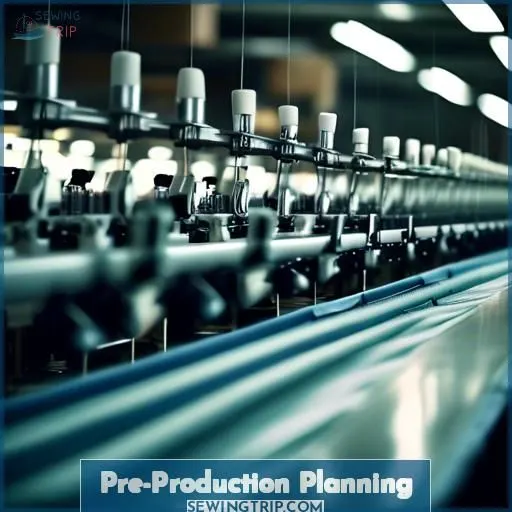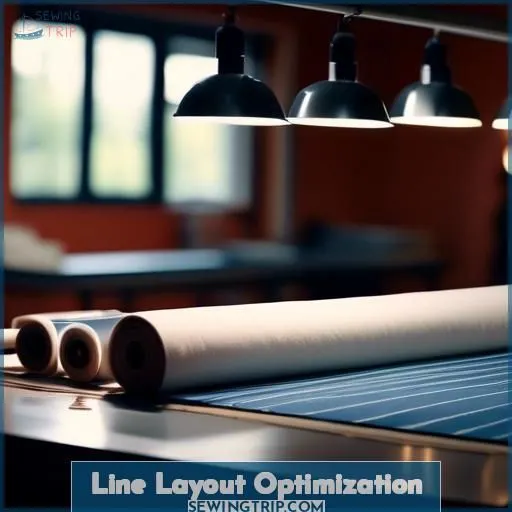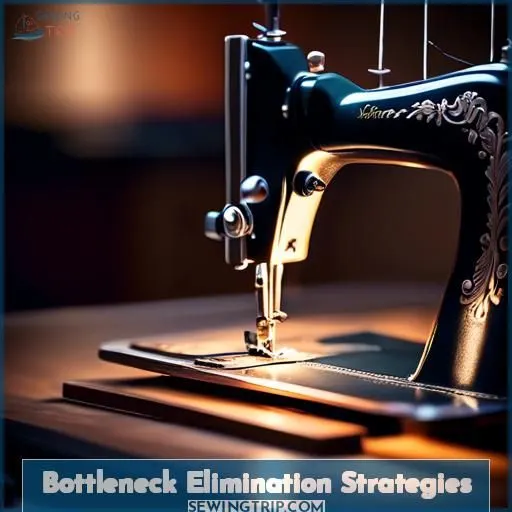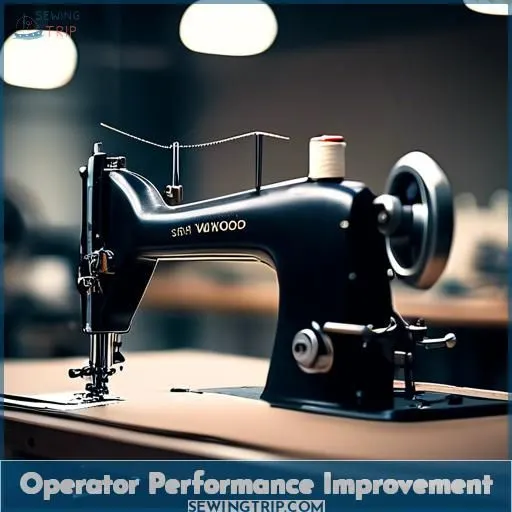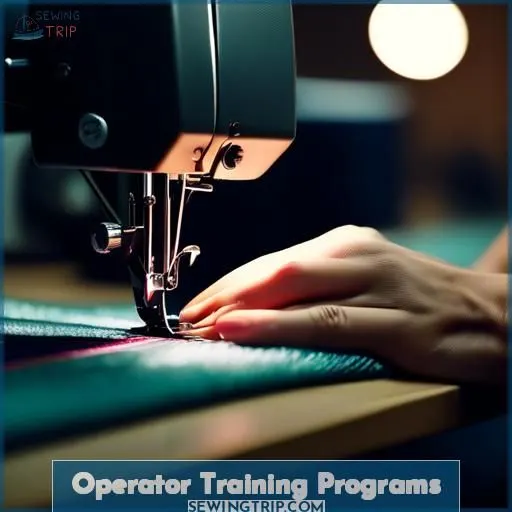This site is supported by our readers. We may earn a commission, at no cost to you, if you purchase through links.

To increase sewing efficiency, you’ll need to streamline your production processes.
Start by optimizing your line layout to minimize material movement and identify bottlenecks.
Balance workloads evenly across workstations through operator multiskilling and pull systems.
Eliminate unnecessary motions through ergonomic workstation design and continuous work supply.
Train operators on correct methods, incentivize skill development, and monitor individual performance.
Guarantee material quality control, set attainable goals, and promote work-life balance.
By implementing these strategies to streamline sewing operations, you’ll discover further avenues to enhance production efficiency.
Table Of Contents
- Key Takeaways
- How to Increase Sewing Efficiency?
- Pre-Production Planning
- Line Layout Optimization
- Line Balancing Techniques
- Bottleneck Elimination Strategies
- Operator Performance Improvement
- Operator Training Programs
- Work Method Optimization
- Production Process Streamlining
- Frequently Asked Questions (FAQs)
- Conclusion
Key Takeaways
- Optimize line layout to minimize material movement and identify bottlenecks.
- Balance workloads evenly across workstations through operator multi-skilling and pull systems.
- Eliminate unnecessary motions through ergonomic workstation design and continuous work supply.
- Train operators on correct methods, incentivize skill development, and monitor individual performance.
How to Increase Sewing Efficiency?
To increase sewing efficiency, planning each step of your project and scheduling sewing time can significantly streamline the process. Utilizing productivity tools like Google Calendar and the Pomodoro technique also helps in managing time effectively.
Pre-Production Planning
Before you plunge into the vibrant realm of sewing production, reserve a moment to delineate your pre-production blueprint.
Consider it as establishing the foundation for an impeccable spectacle.
Cultivate an intimate understanding of your product, both internally and externally.
This entails identifying those pivotal processes that can either elevate or undermine your line’s productivity.
From the outset, prioritize quality control, guaranteeing that your material meets the highest standards.
Additionally, let’s not neglect capacity planning—acknowledging your limitations is paramount.
By concentrating on operator proficiency and efficiency, you’re laying the groundwork for a seamlessly functioning apparatus.
Bear in mind, a robust plan today holds the key to unlocking enhanced efficiency for your line in the future.
Line Layout Optimization
You can enhance workflow by arranging workstations in a sequence that minimizes waiting times and smooths the production flow. Minimizing material movement between operations reduces transportation time, allowing for better WIP visualization to identify potential bottlenecks and enabling workload balancing across lines where similar operations are grouped closely for efficient workforce allocation.
Workflow Enhancement
To enhance workflow in your sewing factory, contemplate these four tactics:
- WIP Management: Monitor the volume of work in progress to maintain a balance between production and capacity. This can assist you in identifying bottlenecks and adjusting your workload appropriately.
- Batch Sequencing: Arrange your work in a manner that enables efficient utilization of machines and workstations. This can mitigate waiting time and augment overall efficiency.
- Takt Time Analysis: Determine the rate at which you need to produce to fulfill customer demand. This can facilitate the optimization of your production schedule and guarantee that you’re meeting your objectives.
- Pull System Implementation: Establish a pull system where work is initiated only when there’s a demand for it. This can alleviate overproduction and enhance efficiency.
Material Movement Minimization
To minimize material movement and enhance your sewing operation, focus on workflow design, layout planning, and space utilization.
Equipment selection plays a vital role in this process.
By optimizing material handling, you can reduce transportation time and improve line balance.
Motion analysis and operator sewing skills are essential components of this strategy.
Conducting motion studies and eliminating avoidable motions can drastically improve efficiency.
Bottleneck Identification
After minimizing material movement, it’s time to tackle bottlenecks.
A keen eye for bottleneck identification sharpens sewing efficiency.
Don’t let bottlenecks strangle your workflow; prevention is key.
Master bottleneck detection, and you’ll weave through production hiccups with the finesse of a skilled tailor.
Line Balancing Strategies
Line balancing strategies are essential for optimizing the productivity of a production line. These strategies aim to minimize idle time, distribute workload evenly, and maximize operator versatility. Here are four key strategies to contemplate:
- Cycle time reduction: Aim to minimize the duration it takes to complete tasks at each workstation. This can be achieved by enhancing operator skills, streamlining work methods, and optimizing equipment usage.
- Workload allocation: Distribute tasks evenly across workstations to ensure that each operation in the line occurs within the designated time frame. This can be done by analyzing the cycle times of each operation and adjusting the workload accordingly.
- Skill assessment: Evaluate the skills of your operators and assign tasks based on their abilities. This can help to reduce idle time and improve overall efficiency.
- Operator flexibility: Train operators to perform multiple tasks, which can increase their versatility and allow for more efficient workstation assignments. This can also help to reduce downtime due to operator unavailability.
Line Balancing Techniques
You can equalize the workload across workstations by breaking down tasks into timed elements and assigning them evenly. Continuously monitor and dynamically adjust the line balance as production dynamics change by cross-training operators for multiskilling and ensuring a balanced mix of manager skill levels overseeing the line.
Workstation Equalization
Workstation flexibility is essential in maintaining a harmonious production line. By distributing tasks judiciously and empowering operators, you can optimize your sewing line for maximum productivity. Here’s how to achieve workstation balance:
- Task Allocation: Assign tasks based on operator capabilities and workload. This guarantees that each workstation is utilized to its utmost capacity, and operators aren’t overwhelmed or underutilized.
- Operator Empowerment: Encourage operators to assume responsibility for their workstations and make decisions that enhance efficiency. This fosters a sense of accountability and can lead to inventive solutions.
- Line Integration: Ensure that workstations are seamlessly integrated, with minimal idle time between stations. This can be achieved by optimizing workflows and reducing material movement.
- Workload Distribution: Monitor workload at each workstation and adjust tasks as necessary to maintain a balanced workload. This may involve reassigning tasks or implementing cross-training programs to increase operator versatility.
- Hand Embroidery Considerations: For hand embroidery, consider using extended stitches to minimize the frequency of thread changes an operator needs to make. This can help maintain a consistent workflow and reduce downtime.
- Waste Knot Management: Ensure that operators are trained to manage waste knots effectively, as these can cause delays and inefficiencies in the production process.
Dynamic Balancing
Dynamic balancing is a critical aspect of line smoothing, making sure workload allocation is efficient and capacity planning is accurate.
By consistently monitoring and adjusting workload, you can optimize utilization and make sure skilled operators are working at their full capabilities.
Keep in mind, a tidy back is just as important as a tidy line, so don’t overlook analyzing workload regularly for embroidery projects.
Operator Multiskilling
Operator multiskilling, also known as cross-training, is an essential aspect of line balancing. It enables operators to gain proficiency in various operations, minimizing downtime and superfluous interruptions.
This adaptability results in a more versatile workforce, allowing the sewing line to adjust to evolving production requirements.
To implement multiskilling, operators should receive training in diverse sewing techniques, such as initiating threads and moving threads. This training not only strengthens their capabilities but also fosters a constructive work environment where operators feel empowered to enhance the line’s efficiency.
Managerial Balance
To further enhance managerial balance in apparel manufacturing, consider these strategies:
- Collaborative Decision Making: Encourage team collaboration to allocate resources effectively and set achievable targets.
- Performance Metrics: Implement metrics to measure managerial effectiveness and track progress in the direction of goals.
- Leadership Development: Invest in leadership development to guarantee a balance of skills among line managers.
Bottleneck Elimination Strategies
To eliminate bottlenecks and enhance sewing efficiency, you’ll need to review your production process sequentially, identifying any operations causing delays or slowdowns. Conduct thorough method studies on these bottleneck areas, observing operator techniques, material flow, and workstation layouts to pinpoint opportunities for improvement.
Sequential Review
In your quest to increase sewing efficiency, start with a sequential analysis. It’s like unraveling a tangled thread; you’ll spot the bottlenecks that slow down your embroidery flow. Sharpen your operator’s sewing skills and develop handy work aids. Remember, in this labor-intensive industry, identifying snags early keeps the fabric of production smooth and the needle flying swiftly across the surface.
Method Study
Performing method studies is essential for uncovering operational challenges and boosting efficiency. Through examination of work methods, you can eliminate redundant movements and create ergonomic workstations to minimize reach time. Additionally, make sure proper work presentation and supply work consistently to operators. Remember, a well-crafted work method can greatly enhance operator performance and overall production efficiency.
Operator Training
To optimize operator performance, it’s essential to implement an effective incentive structure.
Measure performance using key metrics like efficiency levels and production targets.
Regularly assess skills and provide cross-training opportunities for multiskilling.
Motivate operators with performance-based incentives.
Assign tasks based on their strengths.
By focusing on these aspects, you can substantially enhance operator performance and contribute to overall production efficiency.
Work Aid Development
To increase sewing efficiency, work aids are essential in the production process. These aids are designed to improve productivity, maintain quality standards, reduce handling time, and minimize fatigue for operators. Work aids can be categorized into different types, such as folders, guides, specialized pressure feet, and rack guides.
- Folders: These devices are used to fold fabrics prior to sewing, guaranteeing precise and accurate stitching. They can be constructed for specific applications and are available in various widths and capacities. Folders can be placed in the middle or in front of the pressure foot, depending on the application.
- Guides: Guides are used to guarantee correct sewing in predetermined positions or at a specific distance from the fabric edge. They help in maintaining consistent stitching and can be used for various tasks, such as sewing in predetermined positions or maintaining a proper distance from the fabric edge.
- Specialized Pressure Feet: These pressure feet are designed for specific tasks, such as attaching braid or elastic. They’re used to improve the quality of the garments and can be adjusted for different types of materials and thicknesses.
- Rack Guides: Rack guides are used to attach lace, braid, or elastic to garment parts. They help in maintaining a consistent stitch margin and can be used for various tasks, such as sewing lace, braid, or elastic onto garments.
Incorporating work aids into the sewing process can lead to significant improvements in productivity, quality, and operator comfort. By reducing handling time and fatigue, operators can concentrate on their tasks, leading to increased efficiency and better-quality garments.
Operator Performance Improvement
You need to closely monitor each operator’s performance and identify the low performers.
Once identified, conduct method studies to analyze their work techniques and uncover areas for improvement.
Address any issues related to low utilization, such as excessive waiting time or machine breakdowns.
Then, provide thorough training to ensure that all operators are following the correct, optimized methods for maximum efficiency.
Individual Monitoring
Monitoring individual operator performance is essential for sustaining and enhancing efficiency. Track progress utilizing performance metrics, establish feedback mechanisms, and evaluate training effectiveness. Periodic skill assessments facilitate the identification of areas for growth and guarantee sustained learning.
Low Performer Analysis
Low performers in a sewing operation can be identified through root cause analysis, which involves examining the specific issues causing the low performance. Performance improvement can be achieved by addressing these issues through a combination of training needs analysis and skill gap analysis. This can help to improve the operator’s skills and efficiency, ultimately leading to better line performance.
- Root cause analysis: Identify the specific issues causing low performance, such as inadequate training, lack of motivation, or physical limitations.
- Training needs analysis: Assess the operator’s current skills and knowledge, and determine the specific areas where additional training is required.
- Skill gap analysis: Evaluate the operator’s proficiency in various aspects of sewing, such as threading, machine control, and material handling.
- Customized training: Develop a training program designed specifically for the operator’s needs, focusing on the identified skill gaps and performance issues.
- Continuous monitoring and adjustment: Regularly review the operator’s progress and adjust the training program as needed to maintain ongoing improvement.
Utilization Optimization
Utilize material handling techniques to optimize operator performance. Train operators to handle materials efficiently, reducing waiting time and machine downtime. Line balancing strategies can help allocate tasks and resources effectively, minimizing bottlenecks. Regularly identify and address operational issues to maintain high levels of machine utilization.
Correct Method Training
To enhance sewing efficiency, it’s essential to verify that operators are employing the appropriate techniques. Correct method training is a key element of enhancing operator performance. Here are five strategies to boost training effectiveness:
- Skill Development: Invest in on-the-job training to foster sewing abilities.
- Motion Efficiency: Instruct operators to eliminate redundant motions from work methods.
- Performance Improvement: Monitor individual operator performance and address underperformers with method studies.
- Motivation: Implement performance-based incentives to inspire operators.
- Task Assignment: Assign tasks according to operator skills to optimize utilization.
Operator Training Programs
Emphasize developing operators’ sewing abilities through thorough on-the-job training initiatives. Guarantee correct technique is imparted for efficient motions, handling of materials, and work methods, while inspiring operators with incentives rooted in performance to amplify productivity.
Skill Development
To boost sewing efficiency, focus on skill development through effective operator training programs. These programs should include on-the-job training, proper movement and material handling techniques, and performance-based incentives. Assign tasks based on operator skills and provide opportunities for skill enhancement. Remember, well-trained employees lead to increased job satisfaction, motivation, and overall performance.
Motion Efficiency
To enhance motion efficiency in your sewing operations, consider these four strategies:
- Ergonomic Workstations: Design workstations that reduce reach time, ensuring operators can easily access materials and tools.
- Continuous Work Supply: Keep work flowing smoothly by supplying materials continuously to operators, reducing idle time.
- Stitch Anchoring: Start embroidery threads with a waste knot and secure with tiny backstitches, then make anchoring backstitches in the direction of the starting point.
- Thread Traveling: Take a usable thread along a path to a new starting position, whip the backs of stitches on the back of the fabric, and turn the work over to work on the front if no stitches are available.
Incentive Motivation
To enhance sewing efficiency, consider implementing incentive-driven motivation initiatives. Commence by establishing attainable objectives and acknowledging individual contributions. Foster amicable rivalry amidst team members and provide rewards for extraordinary accomplishments. Express gratitude for your employees’ diligence and commitment. This action not merely elevates spirits but also fosters ongoing enhancements.
Task Assignment
In the quest to boost sewing efficiency, task assignment isn’t just about delegating; it’s an art.
- Conduct a thorough task analysis to understand each role’s intricacies.
- Match tasks with employees through skill matching, ensuring a glove-like fit.
- Regular performance evaluations spotlight areas for skill development, turning novices into masters.
Work Method Optimization
To optimize sewing efficiency, you must first conduct thorough motion studies to identify any unnecessary or inefficient movements within your current work methods. By eliminating these superfluous motions and designing ergonomic workstations that minimize strain and reduce reach times, you can streamline processes while ensuring a continuous supply of work to prevent operator downtime.
Motion Study
To optimize your sewing processes, start with motion studies. Capture your operators’ movements to identify inefficiencies and fatigue points. Conduct ergonomics analysis to design workstations that reduce reach time. Map your processes to pinpoint time-wasting steps. By focusing on these areas, you can streamline your production and enhance operator performance.
Unnecessary Motion Removal
Unnecessary motion is the silent killer of work efficiency. It’s like a sneaky thief stealing your time and energy. To increase sewing efficiency, you need to identify and eliminate these redundant movements. Here’s how:
- Motion Study: Conduct a thorough analysis of your work methods to pinpoint unnecessary motions.
- Eliminate Inefficiencies: Once identified, eliminate these redundant motions from your work methods.
- Proper Presentation: Guarantee work is presented correctly to reduce unnecessary motion.
- Continuous Work: Supply work continuously to operators to maintain efficiency.
Ergonomic Workstations
Creating an ergonomic workstation is key to sewing efficiency. Here’s how to make your space work for you:
- Choose chairs that support posture, enhancing seating comfort.
- Arrange tools within arm’s reach, optimizing your workflow.
- Provide ample lighting to reduce eye strain and boost focus.
- Design the layout to allow freedom of movement, preventing fatigue.
Continuous Work Supply
Consistent work supply is critical for sustaining sewing effectiveness. Appropriate work presentation, operator readiness, and thread preparation are vital. Ergonomic tools such as thread guides and needle guides can substantially enhance the process. By guaranteeing continuous supply, you can decrease downtime and heighten productivity.
Production Process Streamlining
You’ll want to eliminate unnecessary interruptions during production to maintain a smooth workflow. Ensuring that only high-quality materials are supplied to operators is critical, as defective materials can disrupt the process and lead to rework or waste.
Interruption Elimination
Eliminate interruptions, streamline your production process.
- Inventory replenishment: Keep materials at hand to avoid delays.
- Equipment maintenance: Regularly check and maintain machinery.
- Quality control: Guarantee standards are met before proceeding.
- Skill development: Train operators to handle tasks efficiently.
Material Quality Control
Ensuring material quality is your secret weapon in the battle against inefficiency. Think of inspection procedures as your quality detectives, sniffing out defects before they wreak havoc. Don’t just take your supplier’s word for it; evaluate them rigorously. Set the bar high with uncompromising quality standards. Remember, defect prevention isn’t just a step, it’s your production process’s guardian angel.
Target Setting
To establish attainable production goals, it’s imperative to discern the abilities of your sewing line. Begin by scrutinizing the Standard Allowed Minute (SAM) for each operation, which denotes the number of minutes required to fabricate a garment. Subsequently, determine the Standard Allowed Hour (SAH) by dividing the SAM by 60. This will elucidate the quantity of garments a line worker can produce during a specified number of working hours.
Next, deliberate on the efficiency objectives for your production line. Efficiency encompasses a blend of performance and utilization, so ascertain that your line functions seamlessly and that operators effectively utilize their working hours. Regular quality inspections and analysis of KPI metrics can assist in identifying patterns and areas for enhancement.
Once you possess a lucid understanding of your production capabilities, you can establish realistic targets for your sewing line. These targets should be predicated on the efficiency objectives you’ve set, as well as any improvement initiatives you may have implemented. Bear in mind, it’s fundamental to monitor and modify these targets periodically to guarantee they remain attainable and germane to your production environment.
Progress Monitoring
To monitor the progress of your sewing production, you need to track efficiency, measure performance, and analyze data. Here are three key steps to help you visualize and improve your production process:
- Efficiency Tracking: Calculate sewing line efficiency using the ratio of produced minutes to spent minutes, multiplied by 100. This will give you a percentage that represents how effectively your line is operating.
- Data Analysis: Regularly review production data to identify areas for improvement. This can include tracking the number of pieces produced by each operation, the time taken for each operation, and the overall efficiency of the line.
- Continuous Improvement: Use the data to make adjustments and improvements to your production process. This might involve rebalancing lines, eliminating bottlenecks, or retraining operators to improve their performance.
Work-life Balance
To achieve work-life balance, consider workstation ergonomics, job satisfaction, motivation strategies, team communication, and employee morale.
Optimize workstations to reduce strain, improve efficiency, and boost worker satisfaction.
Implement incentives and training programs to motivate employees and enhance their skills.
Encourage teamwork and open communication to foster a positive work environment.
By focusing on these aspects, you can create a balanced and fulfilling work environment that boosts productivity and reduces employee turnover.
Frequently Asked Questions (FAQs)
How can I improve my sewing productivity without compromising the quality of my work?
You can streamline processes, optimize workflow, implement ergonomics, and undergo training to enhance skills without sacrificing quality. Stay focused, analyze inefficiencies, and continuously improve methods for maximum productivity.
What are some effective habits to incorporate into my sewing process to enhance efficiency?
Buckle up, my friend! To skyrocket your sewing efficiency, batch tasks relentlessly, master shortcut techniques, and become a lean, mean, fabric-slaying machine. Consistency and laser-focus are key – no dilly-dallying allowed! Stay sharp, and watch your productivity soar.
How can I optimize my sewing space for maximum productivity?
To optimize your sewing space, keep it clutter-free and well-organized. Position your machine for comfortable reach, and store tools within easy grasp. Good lighting and proper seating are key too. Make it a zen-like haven where you can sew efficiently without distractions.
What are some common mistakes to avoid when sewing to maintain efficiency?
Avoid constantly rethreading your machine – it wastes time and effort. Don’t sew over pins, causing jams and broken needles. Keep your workspace organized to minimize hunting for tools or materials. Multitasking is inefficient – stay focused on one task until completion.
How can I effectively manage my time and workflow during sewing projects?
You’ll master time management by batch-prepping tasks, setting realistic goals, and sticking to a routine. Break big projects into smaller, scheduled chunks. Embrace flexibility for life’s curveballs, but stay laser-focused during dedicated sewing sessions. Consistency breeds efficiency – make it a well-practiced habit.
Conclusion
Elevate your sewing efficiency with a streamlined approach. Optimize layouts, balance workloads through multitasking, and eliminate bottlenecks via ergonomic design and uninterrupted work supply. Train operators extensively, reward skill development, and monitor performance diligently. Implement rigorous quality control, establish achievable targets, and foster work-life harmony. By embracing these strategies to enhance sewing efficiency, you’ll unleash exceptional production capabilities.

